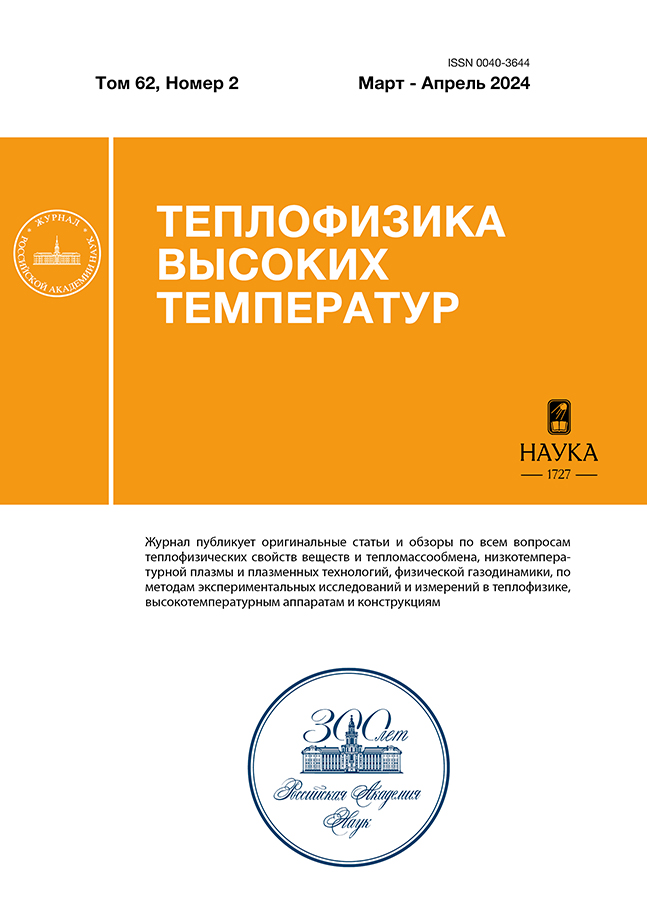О режимах распространения волны саморазложения ацетилена в ударно-нагретых потоках в трубах малых диаметров
- Authors: Герасимов Г.В.1,2, Дракон А.В.1, Еремин А.В.1, Михеева Е.Ю.1
-
Affiliations:
- Объединенный институт высоких температур РАН
- Сколковский институт науки и технологий
- Issue: Vol 62, No 2 (2024)
- Pages: 287-296
- Section: Heat and Mass Transfer and Physical Gasdynamics
- URL: https://rjpbr.com/0040-3644/article/view/653020
- DOI: https://doi.org/10.31857/S0040364424020174
- ID: 653020
Cite item
Abstract
Получены экспериментальные данные о динамике распространения ударной волны в ацетилене и ацетиленокислородных смесях, разбавленных аргоном, в трубе квадратного сечения 27 × 27 мм2. Показано, что энерговыделение при саморазложении ацетилена в определенных условиях может приводить к пульсирующему ускорению фронта ударной волны, однако оно не формирует устойчивой детонации. В стехиометрических ацетиленокислородных смесях формируется детонационная волна, параметры которой хорошо согласуются с расчетными параметрами Чепмена–Жуге. Кинетическое моделирование процесса саморазложения ацетилена и роста конденсированных частиц указало на несовершенство существующих механизмов пиролиза ацетилена и необходимость учета дополнительных каналов полимеризации углеводородных соединений, определяемых его уникальными свойствами.
Full Text
About the authors
Г. В. Герасимов
Объединенный институт высоких температур РАН; Сколковский институт науки и технологий
Email: eremin@jiht.ru
Russian Federation, Москва; Москва
А. В. Дракон
Объединенный институт высоких температур РАН
Email: eremin@jiht.ru
Russian Federation, Москва
А. В. Еремин
Объединенный институт высоких температур РАН
Author for correspondence.
Email: eremin@jiht.ru
Russian Federation, Москва
Е. Ю. Михеева
Объединенный институт высоких температур РАН
Email: eremin@jiht.ru
Russian Federation, Москва
References
- Иванов Б.А. Физика взрыва ацетилена. М.: Химия, 1969. 180 с.
- Емельянов А.В., Еремин А.В., Фортов В.Е. Формирование детонационной волны при термическом разложении ацетилена // Письма в ЖЭТФ. 2010. Т. 92. Вып. 2. С. 101.
- Емельянов А.В., Еремин А.В., Макеич А.А., Фортов В.Е. Формирование детонационной волны при конденсации пересыщенного углеродного пара // ТВТ. 2010. Т. 48. № 6. С. 862.
- Голуб В.В., Гуренцов Е.В., Емельянов А.В., Еремин А.В., Фортов В.Е. Энергетика детонационного пиролиза ацетилена // ТВТ. 2015. Т. 53. № 3. С. 383.
- Еремин А.В., Фортов В.Е. Детонационная волна конденсации // УФН. 2021. Т. 191. № 11. С. 1131.
- Berthelot M., Le Chatelier H.L. Sur la vitesse de detonation da l’acetylene // Comptes Rendus. 1899. V. 129. P. 427.
- Емельянов A.B., Еремин AB., Макеич А.А., Фортов В.Е. Формирование детонационной волны конденсации // Письма в ЖЭТФ. 2008. Т. 87. Вып. 9. С. 556.
- Емельянов А.В., Еремин А.В., Фортов В.Е. Формирование детонационной волны при химической конденсации углеродных наночастиц // ИФЖ. 2010. Т. 83. № 6. С. 1130.
- Emelianov A., Eremin A., Jander H., Wagner H.Gg. Carbon Condensation Wave in C3O2 and C2H2 Initiated by a Shock Wave // Proc. Combust. Inst. 2011. V. 33. Iss. 1. P. 525.
- Browne S., Ziegler J., Bitter N., Schmidt B., Lawson J., Shepherd J.E. SDToolbox – Numerical Tools for Shock and Detonation Wave Modeling. Explosion Dynamics Laboratory. GALCIT Tech. Report FM2018.001. https://shepherd.caltech.edu/EDL/PublicResources/sdt/doc/ShockDetonation/ShockDetonation.pdf
- Манжалей В.И. О детонации ацетилена вблизи предела // ФГВ. 1975. Т. 11. № 1. С. 146.
- Cuoci A., Frassoldati A., Faravelli T., Ranzi E. OpenSMOKE++: An Object-oriented Framework for the Numerical Modeling of Reactive Systems with Detailed Kinetic Mechanisms // Computer Physics Communications. 2015. V. 192. P. 237.
- Goodwin D.G., Moffat H.K., Schoegl I., Speth R.L., Weber B.W. Cantera: An Object-oriented Software Toolkit for Chemical Kinetics, Thermodynamics, and Transport Processes. Version 2.6.0. 2022. https://dx.doi.org/10.5281/zenodo.6387882
- Валишев А.И. Расчет параметров детонации смесей ацетилена // ФГВ. 1997. Т. 33. № 2. С. 98.
- Ranzi E., Frassoldati A., Stagni A., Pelucchi M., Cuoci A., Faravelli T. Reduced Kinetic Schemes of Complex Reaction Systems: Fossil and Biomass-derived Transportation Fuels // Int. J. Chem. Kinetics. 2014. V. 46(9). P. 512.
- Tao H., Wang H.Y., Ren W., Lin K.C. Kinetic Mechanism for Modeling the Temperature Effect on PAH Formation in Pyrolysis of Acetylene // Fuel. 2019. V. 255. P. 115796.
- Saggese C., Ferrario S., Camacho J., Cuoci A., Frassoldati A., Ranzi E., Wang H., Faravelli T. Kinetic Modeling of Particle Size Distribution of Soot in a Premixed Burner-stabilized Stagnation Ethylene Flame // Combust. Flame. 2015. V. 162(9). P. 3356.
- Гуренцов Е.В., Дракон А.В., Еремин А.В., Михеева Е.Ю. К вопросу о влиянии малой примеси ацетона на процесс термического саморазложения ацетилена // ТВТ. 2022. Т. 60. № 6. С. 897.
- Krestinin A.V. Polyyne Model of Soot Formation Process // Proc. Combust. Inst. 1998. V. 27. P. 1557.
- Agafonov G.L., Bilera I.V., Vlasov P.A., Kolbanovskii Yu.A., Smirnov V.N., Tereza A.M. Soot Formation During the Pyrolysis and Oxidation of Acetylene and Ethylene in Shock Waves // Kinet. Catal. 2015. V. 56. P. 12.
- Richter H., Howard J.B. Formation of Polycyclic Aromatic Hydrocarbons and Their Growth to Soot–A Review of Chemical Reaction Pathways // Prog. Energ. Combust. 2000. V. 26. P. 565.
- Eremin A.V. Formation of Carbon Nanoparticles from the Gas Phase in Shock Wave Pyrolysis Processes // Progress in Energy and Combustion Science. 2012. V. 38. Iss. 1. P. 1.
- Knorre V.G., Tanke D., Thienel T.H., Wagner H.Gg. Soot Formation in the Pyrolysis of Benzene/Acetylene and Acetylene/Hydrogen Mixtures at High Carbon Concentrations // Proc. Combust. Inst. 1996. V. 26. P. 2303.
- Yoshizawa Y., Kawada H., Kurokawa M. A Shock-tube Study on the Process of Soot Formation from Acetylene Pyrolysis // Proc. Combust. Inst. 1979. V. 17. P. 1375.
- Tanzawa T.W., Gardiner C.J. Thermal Decomposition of Acetylene // Proc. Combust. Inst. 1979. V. 17. P. 563.
Supplementary files



















